Sebae anemone is commonly known as Leather anemone, Leathery sea anemone, Long tentacle anemone, Purple tip anemone, or Leathery Sebae sea anemone. This fairy-like creature is an excellent addition to your aquarium. But to add this valuable creature to your collection, you should have advanced knowledge regarding the Sebae anemone. Do not worry, and I will make you an expert on Sebae anemone through this article.
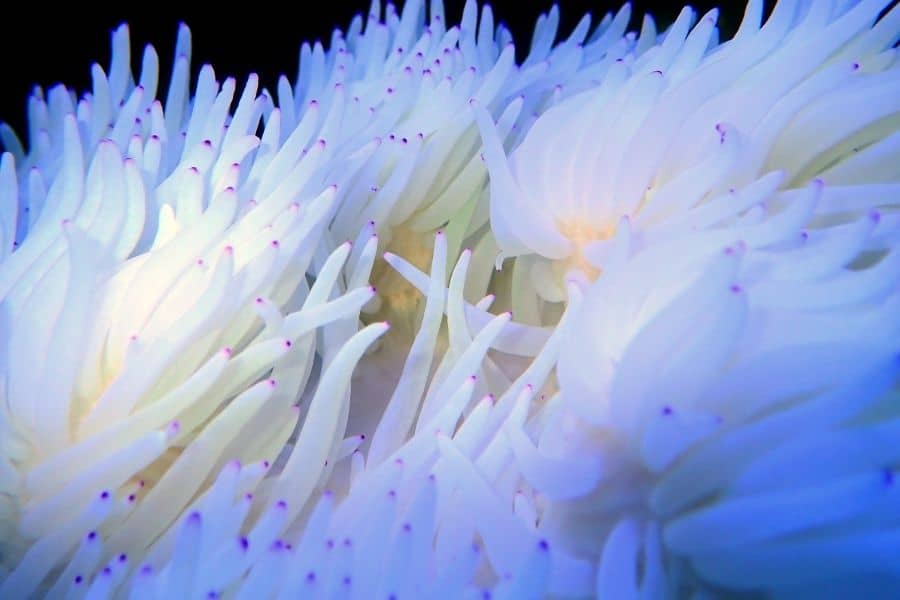
Quick Overview
Jump To
- 1 Quick Overview
- 2 The Appearance Of Sebae Anemone
- 3 Other Species of Heteractis Genus
- 4 Behavior of Sebae anemone
- 5 Sebae Anemone and Clownfish
- 6 Tank Requirements of Sebae anemone
- 7 How Long Do Sebae Anemones Live?
- 8 How to Frag Or Propagate Sebae Anemone
- 9 How Fast Does Sebae Anemone Grow?
- 10 What Does Sebae Anemone Eat?
- 11 How To Feed Sebae Anemone?
- 12 Predators Of Sebae Anemone
- 13 Why Is Sebae Anemone Dying?
- 14 FAQ
- 15 Source
| Scientific name | Heteractis crispa |
| Common name | Leather anemone Leathery sea anemone Long tentacle anemone Purple tip anemone Leathery sebae sea anemone |
| Care level | Difficult |
| Price | Around $70 |
| Reef Compatible | Reef safe |
| Native to | Tropical and subtropical waters of the Indo-west Pacific Ocean area |
| Type (soft or hard coral) | Soft |
| Color | Column’s color is violet, whitish, or greenish. Tentacles are mauve, brownish grey, or green |
| Tank size | Minimum – 50 gallons tank |
| Preferred Temperature | 72-79 Fahrenheit |
| Calcium Magnesium Phosphate Alkalinity pH level Salinity | 380-430 ppm 1200-1350 ppm 0 ppm 8-12 dKH 8.1-8.4 1.023-1.025 Specific gravity |
| Size of the animal | Around 30 cm |
| Growth rate | No exact growth rate |
| Temperament | Semi-aggressive |
| Recommended tank mates | Clownfish and juveniles of Three spot dascyllus |
| Preferred food | Shrimp Fish Mussel Zooxanthellae Krill |
| Feeding frequency | Large- daily Medium – 5 times per week Young or small – 2 to 4 times per week |
| Propagation by | Sexually and asexually |
Scientifically, they are called Heteractis crispa. This creature belongs to the Stichodactylidae family. They are reef-safe species. Sebae Anemone is native to the tropical and subtropical waters of the Indo-west Pacific Ocean area. They mostly live in waters at depths of 10 to 100 ft (3 to 35 m). Mostly, they wedge in rock crevices. On the surface, you can see their only oral disk and tentacles.
There is a symbiotic relationship between S anemone and clownfish. Both species fulfill their protection and nourishment needs from this relationship. This anemone protects from threats or attacks and hunts prey by using its venomous cells or nematocysts in its tentacles.
The Appearance Of Sebae Anemone
Nature has colored the Sebae anemone by using grey or violet-brown. S anemone has a leathery look, and that’s why they are called Leather anemones or Leathery sea anemones. They have a stuck foot at the base of their pedal column, and this sticky foot helps to adhere to the different surfaces. If the Sebae anemone does not prefer the condition or environment where they live, they will move by using their foot. When compared with other anemones, This anemone’s foot is larger than the column.
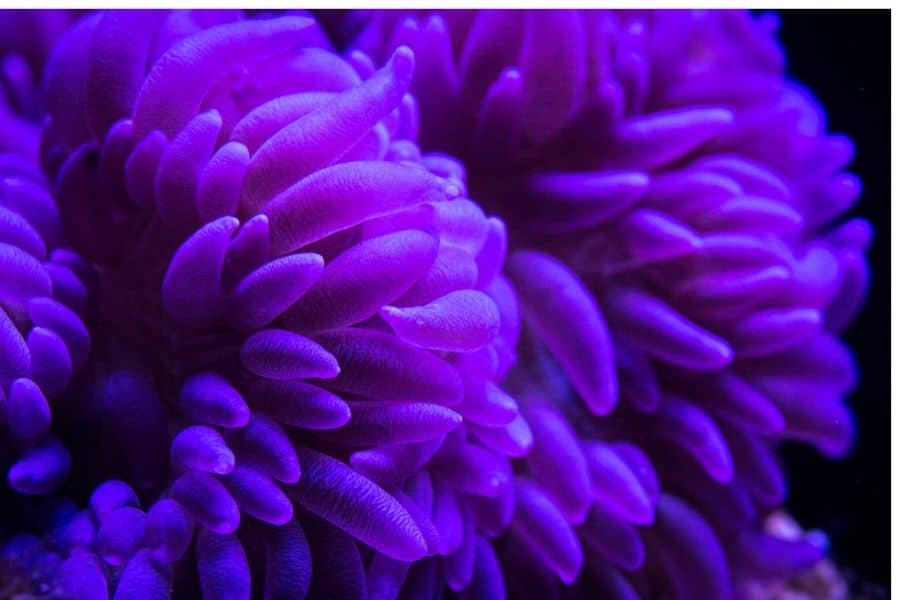
Generally, their column’s color is violet, whitish, or greenish. anemone has around 800 tentacles attached to the oral disk.
They have longer tentacles around 1.5 to 2.5 inches in length. Tentacles are so long that they are usually intertwined. The size of their tentacles is like the length of the bubble tip anemone. The tips of the tentacles are rounded.
Commonly, tentacles of Sebae anemone are mauve, brownish grey, or green. But you can find some species with tips containing beautiful color ranges such as; Purple, Blue, and Mauve. Tentacles of Sebae anemone are situated all over the surface of its oral disk. It gives a “mop” appearance to the anemone. The mouth of the anemone is in the center, and it is visible barely. Typically, the S anemone’s mouth is closed and tight. But when they are hungry, their mouth will open. When the mouth opens, it is oval-shaped. If the anemone is gaping its mouth, it is a warning signal.
Other Species of Heteractis Genus
Heteractis aurora
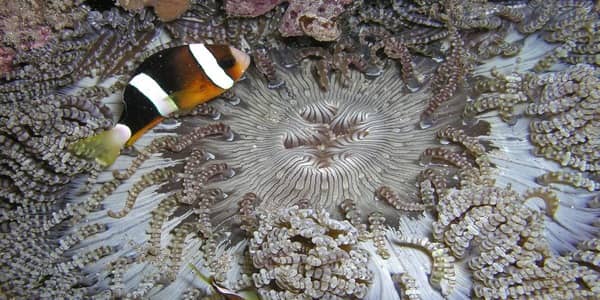
| Common names | Beaded sea anemone Glass beaded sea anemone Beaded sand anemone Aurora anemone Glass pearl anemone Flat anemone |
| Origin | Indo-Pacific Ocean from Red sea and East to Japan in the north Mauritius to the South |
| Color | Grey-green to chestnut brown |
| Required Water condition | |
| Minimum tank size | 50 gallons |
| Calcium level | 380-450 ppm |
| Alkalinity level | 7-11 dKH Ideal level is 10 dKH |
| Magnesium level | 1250-1350 ppm |
| pH level | 8.1-8.4 |
| Substrate type | sand |
| Lighting condition | High-strong lighting |
| Temperature | 72-79 Fahrenheit |
| Specific gravity | 1.023-1025 SG |
| Water flow | Moderate |
Heteractis magnifica
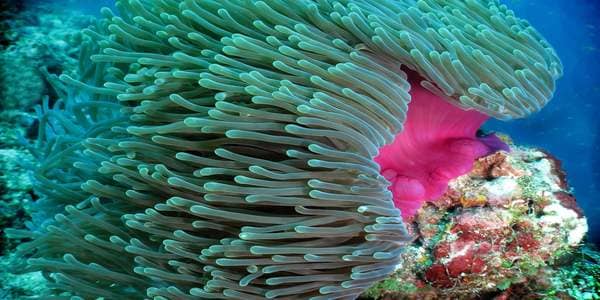
| Common names | Ritteri anemone Bulb-tip anemone Purple base anemone Maroon anemone Yellow tipped long tentacle anemone |
| Origin | Indo-Pacific Ocean from the Red sea to Somoa |
| Color | Column- avocado green, greenish-browns, and white Tentacles and oral disk- green, yellow, white, sky blue, and magenta. |
| Required Water condition | |
| Minimum tank size | 50 gallons |
| Alkalinity level | 3.5 mq/l |
| pH level | 8.1-8.4 |
| Substrate type | Any substrate |
| Lighting condition | High-strong lighting |
| Temperature | 72-82 Fahrenheits |
| Specific gravity | 1.023-1025 SG |
| Water flow | Moderate |
Heteractis malu
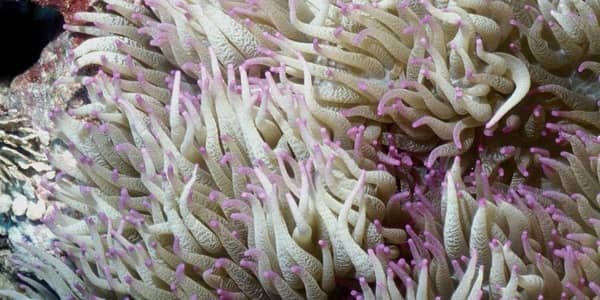
| Common names | White sand anemone Singapore sebae anemone Hawaiian sand anemone Sebae anemone |
| Origin | Eastern Pacific Ocean Near the Hawaiian island |
| Color | White with purple, green, pink, white, magenta, tan or, brown tips. |
| Required Water condition | |
| Minimum tank size | 50 gallons |
| Alkalinity level | 3.5 mq/l |
| pH level | 8.1-8.4 |
| Substrate type | sand |
| Lighting condition | High-strong lighting |
| Temperature | 74-83 Fahrenheit |
| Specific gravity | 1.023-1025 SG |
| Water flow | Moderate |
Behavior of Sebae anemone
Sebae anemone is semi-aggressive. but compatible with marine fish. If you see this anemone wander around the tank, the reason is poor conditioning. The water condition is not ideal for the Sebae anemone; they try to move away from the place and find a suitable location with a preferable water condition. They should need their own space. If not, you can experience chemical warfare between the species. It can cause one species to strike the feeds, shrink or even die.
Sebae Anemone and Clownfish
There is a “symbiotic” relationship between the Sebae anemone and the clownfish. This relationship generates benefits for both species. Clownfish protect S anemone from anemone-eating fish species. Anemone protects the clownfish from predation too. Anemones can collect foods that do not eat by clownfish. Further, there is a belief that anemone feeds the waste of clownfish. If you add a clownfish, the anemone is 3 to 4 larger in diameter than the length of the clownfish that you introduced.
Note : For example, you should choose a 1-1.5 inches clownfish for a 4-6 inches Sebae anemone.
If you hope to introduce a clownfish, it is better to place the anemone first in your tank. Then give a few months to it. This time will allow the anemone to acclimate to the new environment and grow. Mainly, you cannot keep all clownfish species with the Sebae anemone in the same tank. Bellow are specific clownfish species that can live with this anemone. These are;
- Clark’s Clownfish (Amphiprion clarkii)
- Pink Skunk Clownfish (Amphiprion perideraion)
- Saddleback Clownfish (Amphiprion polymnus)
- True Percula Clownfish (Amphiprion percula)
- Three-band Clownfish (Amphiprion tricinctus)
- Orange-fin Clownfish (Amphiprion chrysopterus)
- Barrier Reef Clownfish (Amphiprion akindynos)
- Two-band Clownfish (Amphiprion bicinctus)
- Red Saddleback Clownfish (Amphiprion ephippium)
- Wide-band Clownfish (Amphiprion latezonatus)
- White-bonnet Clownfish (Amphiprion leucokranos)
- Red and black Clownfish (Amphiprion melanopus)
- Oman Clownfish (Amphiprion omanesis)
- Orange Skunk Clownfish (Amphiprion sandaracinos)
Tank Requirements of Sebae anemone
The basic fact is the tank requirements when you rear any fish or coral species in your aquarium. Therefore, to generate a happy and healthy Sebae anemone, you should follow the following guides. Also You should perform water changes in the right way. For example;
| Bimonthly | 10% water changes |
| Monthly | 20% water changes |
When setting up the tank, you should create about 4 to 8 inches sand bed. It helps Sebae anemone to bury their foot.
Special note: You can use Purigen and Poly-fiber products to maintain water quality.
Purigen product – remove the soluble and insoluble impurities from the water in the tank. It causes to maintain the ammonia, nitrates, and nitrites level of the water.
Size of the Tank
The recommended minimum tank size is 50 gallons (190L) to rear these anemones. But if you expect to keep two Sebae anemones in the same tank, you should have at least 4-5 feet long tank. If you do not provide enough space for them, it can be caused chemical warfare between the anemones. An excellent filter system and large tank (over 100 gallons) are the best things when rear the two S anemones. To prevent wandering into each anemone’s space, you can build a natural blockade.
Water Quality
| pH level | 8.1-8.4 |
| Specific gravity | 1.023-1.025 |
| Calcium | 380-430 ppm |
| Phosphate | 0 ppm |
| Magnesium level | 1200-1350 |
| Temperature | 72-79 Fahrenheit |
| Alkalinity level | 8-12 dKH |
Flow Rate
Sebae anemone lives happily in an area that has a moderate flow rate. So using an aquarium wavemaker can keep them happy. But make sure to use wavemakers that are safe to anemone or one containing anemone covers.

Lighting
You should keep a moderate to high lighting condition for the Sebae anemone. Try below.
- USA Orbit Marine LED Aquarium Light – Saltwater, Coral Reef Fish Tank
- NICREW Marine LED Fish Tank Light for Reef Tanks
- VIPARSPECTRA Timer Control Dimmable 165W 300W LED Aquarium Light Full Spectrum for Grow Coral Reef Marine
How to Place Anemone In A Tank
Before placing the Sebae anemone, you should follow the acclimating process. You should place them in an area that has moderate water flow and moderate to the high lighting condition. It would be best to place them on the sand bed, and it should be about 4 to 8 inches deep. If you rear more than one anemone, you should highly consider the space. Therefore, if you do not provide adequate spaces for them, it can be caused chemical warfare. Therefore, when you are placing the anemone, you should place them with enough space.
How Long Do Sebae Anemones Live?
There is no exact estimation of the lifespan of Sebae anemone. Some anemones can live hundreds of years old in the wild. Therefore, some anemone’s life span shortens to 80 years in captivity with proper care. But you can keep them for a long time in your tank. Here is a way to keep them longer and healthier.
- You should feed your Sebae anemone with quality and nutrition-rich foods.
- The tank setup and water parameters should be at the preferable level.
- Lighting conditions and water flow should meet the ideal level.
- Place the anemone in a better place with enough space.
- Eliminate the stressful factors of anemone
How to Frag Or Propagate Sebae Anemone
Typically, Sebae anemone does not breed in captivity. It isn’t easy. There are two ways to multiply the population of Sebae anemones.
- Sexual
- Asexually
Asexually Breeding Method
Fission is the one method. Therefore, Sebae anemone is split in half from the mouth and the foot. Through this, they form clones. The clone is similar to the twins.
Sexual Breeding Method
Also, Sebae anemone reproduces by male and female sex glands or pairs with another anemone of the opposite sex.
- The ultimate result of this method is larvae called “ciliated planula larvae”.
- When larvae appear they fall to the seafloor.
- The larvae grow a pedal disk
- Then start to grow into a new Sebae anemone
Note: The sexual difference cannot identify by the appearance of Sebae anemone.
How Fast Does Sebae Anemone Grow?
Sebae anemone can grow up to 30 cm (12 inches). Generally, there is no exact growth rate. The growth rate depends on the:
- Feeding frequency and quality of the foods
- Stability of preferred water parameters
- Comfortability of the environment that they live in (lighting, water flow, and other required factors).
Special note: Usually, in my experience, Sebae anemones grow fast. They reached 3-7 inches within around 5-6 months.
What Does Sebae Anemone Eat?
Sebae anemone is a carnivore species. They eat animal matter to collect the required nutrients to live.
In the wild:
- Sebae anemone collects the most required nutrients from the zooxanthellae. There is a symbiotic relationship between these algae and Sebae anemone. Therefore, Zooxanthellae algae live in the tissues of anemones.
- They catch the prey to feed by using venomous cells and nematocysts in their tentacles.
- Further, anemone fulfills its nutrient requirements by absorbing nutrients that contain in the water.
- S anemone also feeds the waste of the resident animals. A closer example is clownfish.
Note: Most of the time, clownfish brings chunks of food for Sebae anemone.
In captivity
- Fresh shrimp
- Fish
- Mussel
- Krill
- Baby Scallops
Note: You can reach an outstanding achievement by serving the Sebae anemone with mix diet.
How To Feed Sebae Anemone?
- Take a small cup and fill it with aquarium water.
- Soak the diet of the water in the cup.
- Wait about 20-30 minutes.
- Then chop the foods and feed your Sebae anemone.
A. Feeding Frequency
Feeding frequency depends on the size and age of the Sebae anemone.
- It would be best if you fed giant Sebae anemone daily.
- It is recommended to provide the medium size anemone five times per week.
- Small or young anemone needs food 2 to 4 times per week.
B. After Feeding
- You should remove the uneaten food particles from the tank.
- A properly functioning filter system is an added advantage.
Note: Uneaten foods can produce ammonia, nitrate, and nitrite in your tank. These byproducts can harm your fish species and corals, including Sebae anemone.
Predators Of Sebae Anemone
- Nudibranchs – Nudibranchia
- Sea stars – Asterias rubens – the coral-eating famous starfish
- Crown-of-thorns starfish – Acanthaster planci or COTS
- Angelfish – Pterophyllum
- Other anemones – Actiniaria
- Bristle worms – Polychaeta
Note: In addition to these species, you should avoid keeping other fish species, non-fish species, and coral species that are not reef safe. Try to gather significant knowledge about the species before adding them to the aquarium.
Related : Bubble Tip Anemone (Entacmaea quadricolor) 9 Important Facts
Related : Rock Flower Anemone | Beautiful Rock Flowers
Read : Long Tentacle Anemone | Beginners To Expert Care Guide |
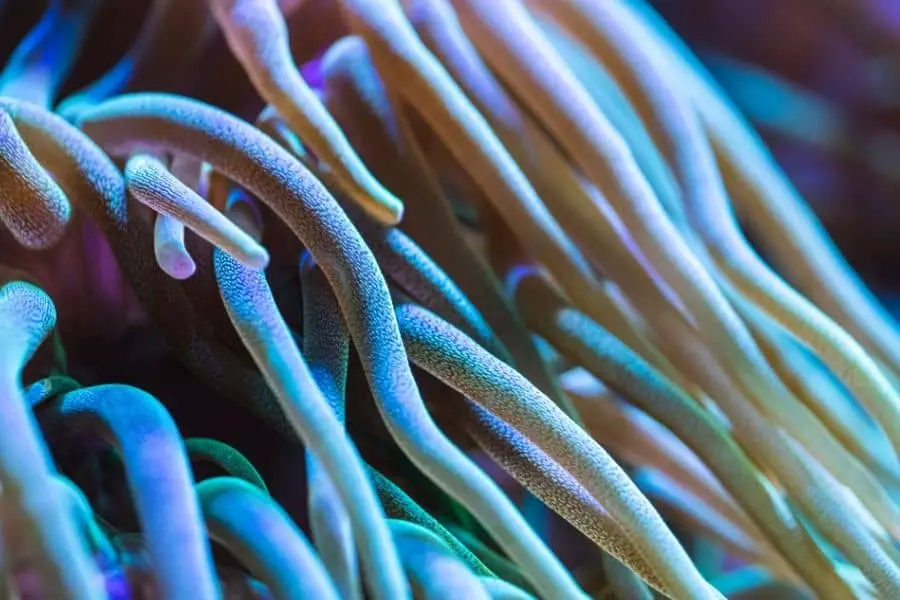
Why Is Sebae Anemone Dying?
There are many reasons to happen in your aquarium.
Diseases/ Ailment
Sebae anemone can die due to the diseases. You can save them by offering ideal lighting conditions, water flow, water quality parameters, and quality feeds. If you observe them closely, you can recognize whether they like the conditions that you provide or not. Sebae anemone tends to move when they do not accept the current condition in the area where they live.
Predatory Activities
Predators can stress the Sebae anemone. Continuous predatory behaviors can be caused to the death of an anemone.
Chemical Warfare
If you do not provide enough space for the 2 Sea anemones, it can be caused chemical warfare between the anemones. You can prevent this by creating at least 4-5 feet-long tanks for them.
Poor Water Quality
If Sea anemones cannot tolerate the poor water conditions. Therefore, you should maintain stable water parameters in your tank.
Lack of Lighting Condition
If you do not create an area with moderate to high lighting conditions in the tank, Sea anemones cannot survive.
Poor Water Flow
Sea anemones require moderate water flow to live in the aquarium. Changes in the flow rate can be caused even death.
Inadequate Feeds
You should feed the sea anemones properly. If not, they will weaken and cannot live healthily.
Absence of Acclimation
If you do not help them adjust to the new environment gradually through the acclimation process, it can be caused to generate harmful impacts to the Sea anemones.
FAQ
Are Sea Anemones Hard To Care For?
Sebae anemones are hard to care for due to their preferable lighting condition and ultimate size. You should provide a large tank to survive them with their maximum size. Further, you should maintain the suitable lighting condition properly. Therefore, It is not better to place them in a new tank. they will help if you put them in at least a one-year-old tank.
It would be best if you fed the Sebae anemone regularly and correctly. Lack of feeding can be recognized as the second biggest fault for most unhealthy S anemones or deaths in captivity. Sebae anemones can easily stress, especially from the capture and shipping process of the anemone. Also, you should remove them from the surface very carefully because tissue damage can kill the S anemone.
Will Sebae Anemone Eat Fish?
All varieties of sea anemones, including Sebae anemones, eat fish. Therefore, you can feed them fish. On the other hand, do not keep small fish with your anemone in the same tank.
Do Anemones Shrink At Night?
In the wild, anemones tend to deflate partially in the nighttime. Here anemones do not shrink completely. But if you see carefully, the size of the anemone during the daytime is more prominent than at night.
Do Sebae Anemones Poop?
Sebae anemone will poop, and it can increase the ammonia level of the tank water.
